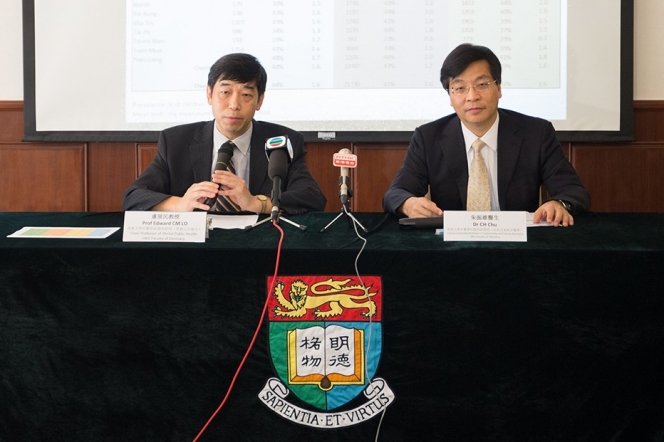HKU Faculty of Dentistry finds high prevalence of dental caries among kindergarten children

Professor Edward Lo and Dr CH Chu of HKU Faculty of Dentistry present research findings at the press conference.
Data canvassed by an outreach dental service programme at the Faculty of Dentistry of the University of Hong Kong has revealed that there was a high prevalence of tooth decay among kindergarten school children in the territory.
The programme by the university’s dental school has conducted dental check for nearly 23,000 kindergarten children in the academic year of 2014/15. Nearly 40%, that is 2 out of 5 children, were found to have tooth decay and on average they had approximately 1.5 decayed teeth.
Compared to findings from similar studies conducted in past two academic years, both the overall prevalence rate and mean number of decayed teeth showed a slight drop.
The overall prevalence rate of dental caries experience in kindergarten children has decreased from 44% (2012/13) and 41% (2013/14) to 37% (2014/15). The mean number of decayed teeth dropped from 1.6 in both 2012/13 and 2013/14 to 1.5 in 2014/15.
Despite the downward trend, the overall prevalence rate of dental caries in preschool children is still relatively high when compared to some other places in the world: 23% for 2-5 age group in US; 28% for 5-years old in UK; and 18% for 3-year olds in Japan.
The data also disclosed that the kindergarten children in three districts (Sham Shui Po, Wong Tai Sin and North district) were more vulnerable to tooth decay, where these kindergarten children had the highest mean number of decayed teeth, with 1.9 to 2 decayed teeth on average. The difference in prevalence rate between districts of the highest (Sham Shui Po) and the lowest (Kowloon City and Tsuen Wan) could vary as much as 22%.
The Faculty of Dentistry’s Chair Professor in Dental Public Health Professor Edward Lo said the high prevalence of dental caries in kindergarten children is worthy of concern.
“It shows that many parents do not pay sufficient attention to the dental condition of their kids, and small children are rarely taken to dentists for dental check or treatments.
Some parents may have the misconception that primary teeth with dental caries need no treatment as they will soon fall off to be replaced by permanent teeth.” Professor Lo said.
Professor Lo added that apart from the pain, untreated tooth decay can lead to systemic infection, affecting the general health of children. In rare serious cases, dental caries can be fatal.
SDF proven to stop caries from worsening
Meanwhile, silver diamine fluoride (SDF), a medicament pioneered by the HKU Faculty of Dentistry to stop the aggravation of tooth decay in Hong Kong, has been proven effective in a recent study that examined its efficacy over an 18-month period.
The study, entitled “A randomized clinical trial on arresting dentine caries in preschool children by topical fluorides – 18 month results” was published online in May in the Journal of Dentistry.
The HKU Faculty of Dentistry hopes the clinical successes will help broaden and extend the application of SDF, while lower the rate of tooth decay in the population.
In the study, 304 preschool children with 1,670 tooth surfaces with decay into dentine were grouped into 3 groups, with Group1 (SDF once a year) receiving application of 30% SDF solution every 12 months; Group 2 (SDF intensive) receiving a more intensive 3 applications of 30% SDF solution at weekly interval; and Group 3 (NaF intensive) having 3 applications of 5% sodium fluoride (NaF) varnish at weekly interval.
The results showed that the tooth decay inactivation rates at the tooth surface level for the three groups were 35%, 40% and 27% respectively, with the SDF solution having a significantly higher rate.
The findings also revealed that inactivation rate of decayed teeth that received 3 applications of SDF solution at baseline (Group 2) are higher than those who had received only one SDF application at baseline (Group 1).
SDF solution is also found to be more effective than NaF varnish, regardless of the application frequency or intensity; it also significantly shortened the time to put the tooth decay under control.
Dr Chu Chun-hung, Clinical Associate Professor in Community and Family Dentistry and a member of the research team, suggested that either of the two SDF application protocols (SDF once a year or SDF intensive) can be adopted by dentists when a non-restorative treatment approach is chosen for managing decayed cavities in primary teeth.
Dr Chu said despite the side effects of staining caused by topical application of SDF, the medicament can be an effective and efficient solution to controlling tooth decay in young children.
“It is important that tooth decay in young children should be diagnosed and treated early because advanced decay will progress into the tooth pulp, leading to toothache, abscess and loss of tooth,” he said.
Dr Chu advised that children, same as adults, should brush twice a day and parents should help their kids maintain a healthy diet with less intake of sugar and snacks.
He also said parents should take their children to the dentist for regular dental check.
For media enquiries, please contact:
HKU Faculty of Dentistry, Tel: 2859 0494; E-mail: dentke@hku.hk